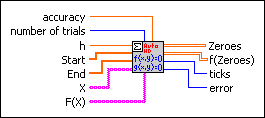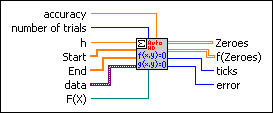 |
accuracy controls the accuracy of the zero determination. The default is 1.00E-8, which specifies the maximum deviation of the calculated solution from the actual solution.
|
 |
number of trials is the elaborate number of randomly chosen start points. The algorithm starts with these points and looks for zeros close to these points. The default is 5.
|
 |
h is a small distance to calculate derivatives. The default is 1E-8.
|
 |
Start is an array describing the left corner of the n-dimension interval. The randomly chosen start points of the zero-finding algorithm can be found in the n-dimensional rectangle spanned by Start and End.
|
 |
End is an array describing the right corner of the n-dimension interval. The randomly chosen start points of the zero-finding algorithm can be found in the n-dimensional rectangle spanned by Start and End.
|
 |
X is an array of strings representing the x variables. If the array of strings contains the variable t, the VI returns an error.
|
 |
F(X) is an array of strings defining the functions in n dimensions. The formula can contain any number of valid variables.
|
 |
Zeros contains the determined zeros of F(X).
|
 |
F(Zeros) contains the function values of Zeros. Usually, these values are close to 0.
|
 |
ticks is the time in milliseconds to analyze the formula and to produce the Zeros.
|
 |
error returns any error or warning from the VI. You can wire error to the Error Cluster From Error Code VI to convert the error code or warning into an error cluster.
|
 |
accuracy controls the accuracy of the zero determination. The default is 1.00E-8, which specifies the maximum deviation of the calculated solution from the actual solution.
|
 |
number of trials is the elaborate number of randomly chosen start points. The algorithm starts with these points and looks for zeros close to these points. The default is 5.
|
 |
h is a small distance to calculate derivatives. The default is 1E-8.
|
 |
Start is an array describing the left corner of the n-dimension interval. The randomly chosen start points of the zero-finding algorithm can be found in the n-dimensional rectangle spanned by Start and End.
|
 |
End is an array describing the right corner of the n-dimension interval. The randomly chosen start points of the zero-finding algorithm can be found in the n-dimensional rectangle spanned by Start and End.
|
 |
data contains arbitrary values that pass to the VI that implements the function.
|
 |
F(X) is a strictly typed reference to the VI that implements the function. Create this VI by starting from the VI template located in labview\vi.lib\gmath\zero.llb\Zero Finder f(x) nD.vit.
 Open template Open template
|
 |
Zeros contains the determined zeros of F(X).
|
 |
F(Zeros) contains the function values of Zeros. Usually, these values are close to 0.
|
 |
ticks is the time in milliseconds to analyze the formula and to produce the Zeros.
|
 |
error returns any error or warning from the VI. You can wire error to the Error Cluster From Error Code VI to convert the error code or warning into an error cluster.
|
As an example of using the nD Nonlinear System Solver VI, determine the solutions for the following nonlinear system.
To obtain solutions for the preceding nonlinear system, enter the following values on the front panel.
 Add to the block diagram
Add to the block diagram Find on the palette
Find on the palette











